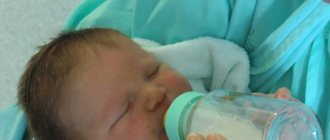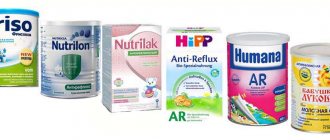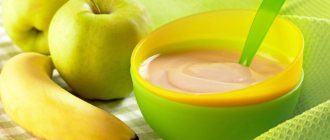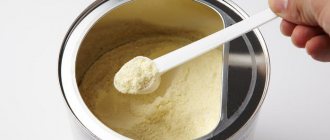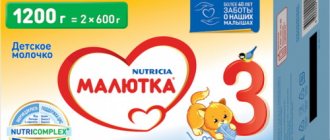Nine exciting months of waiting for the baby are behind us, a name has finally been chosen, and even photos from the discharge from the maternity hospital are ready. But any experienced mother will say with confidence: this is just the beginning! Each new stage of the baby’s growing up is associated with new doubts and worries for the mother. Any baby will definitely go through a period of “tummies”. Bloating, discomfort and colic may well be a natural physiological stage that will pass without a trace. But there are symptoms that may hide lactase deficiency. If you notice diarrhea, green stools in your baby, frequent flatulence, vomiting, or poor weight gain, this may indicate lactase deficiency.
List of low-lactose infant formulas
- “Humana LP (therapeutic nutrition).” Contains about 90% casein, made with the addition of maltodextrin and potato starch.
- “Humana LP + MCT (medium chain triglycerides).” Glucose syrup, casein components and maltodextrin predominate. Medium chain triglycerides promote better absorption of the fat component.
- "Bellakt low latose." Protein components predominate. The lactose content per 100 ml of the finished mixture is 1 gram.
- “Low-lactose Similak” contains whey protein and casein in a 50/50 ratio. Lactose is present in an amount of 0.2 g/100 ml of the mixture. The same lactose content is found in other lines of this product, “Similak antireflux”, “Similak comfort”.
- "Nestozhen low-lactose." Carbohydrate components are glucose syrup, maltodextrin and lactose.
- "Humana SL". Soy protein in it 100% replaces the animal protein component.
- "NAN lactose-free." Whey protein and casein predominate with the addition of maltodextrin.
- "Nutrilak lactose-free." Whey protein and casein are balanced in equal proportions.
- "Nutrilak soy". Contains soy protein with amino acid composition and glucose.
- "Frissauce." Created on the basis of soy protein isolate with the addition of amino acids.
- “Bellakt without lactose” Consists of whey protein 40% and casein 60%
- "Celia." The protein ratio is identical to Bellakt, and the indications for use are similar.
- “Grandma’s basket without lactose.” Casein with added glucose and maltodextrin.
List
| Name | Appearance | Brief description of the composition | price, rub. |
| "Similac low lactose" from 0 to 12 months, 375 g | The ratio of whey proteins to casein is 50/50, lactose content is 0.2 g per 100 ml of mixture, contains the addition of maltodextrin. For children with hypersensitivity to lactose and diarrhea. | 680 | |
| "Bellakt NL" from 0 to 12 months, 400 g | Protein component with a predominance of whey proteins 60/40, lactose content 1 g per 100 ml of mixture, maltodextrin added. For children with secondary lactase deficiency, after diarrhea, to reduce colic. | 285 | |
| "Nestozhen low-lactose" from birth, 350 g | The carbohydrate component is represented by lactose, glucose syrup, and maltodextrin. For lactase deficiency and after diarrhea. | 275 | |
| "Humana LP" from 6 months, 300 g | Casein content is about 90%, maltodextrin and potato starch are added. Lactose content 1.1 g per 100 ml of mixture. Acute intestinal infections, diarrhea of various types, partial lipase deficiency, secondary lactase deficiency, flatulence, colic, regurgitation. | 710 | |
| “Humana LP + MCT” for nutrition of children from 6 months and adults, 300 g | It is characterized by a predominance of the casein fraction and contains maltodextrin glucose syrup. Lactose 0.5 g per 100 ml of mixture. Contains medium chain triglycerides that promote better absorption of the fat component, breaking down without the participation of pancreatic and intestinal lipase. For digestive disorders of various origins, for intestinal disorders in the acute stage and during the recovery period. | 819 | |
| "Similac hypoallergenic" 1.2, 400 g | The protein consists entirely of partially hydrolyzed whey protein. Lactose content 0.2 g per 100 ml of the finished mixture. Recommended for secondary lactase deficiency complicated by allergic reactions. | 625 | |
| "Similac antireflux" from 0 to 12 months, 375 g | The ratio of whey protein and casein is 50/50. Contains starch to prevent regurgitation. Lactose content 0.2 g per 100 ml of the finished mixture. Recommended for secondary lactase deficiency and regurgitation. | 681 | |
| "Similac comfort" 1.2, 375 g | The protein consists entirely of partially hydrolyzed whey protein. Lactose content 0.2 g per 100 ml of the finished mixture. Probiotics added. Recommended for secondary lactase deficiency and digestive disorders. | 549 |
Lactose-free formulations for babies with food allergies and glactosemia
- "Nutrilon amino acids." Contains various types of amino acids that completely replace protein components; Of the carbohydrate components, only glucose syrup is represented.
- Alphare Amino. Just like Nutrilon, it consists of amino acids instead of proteins, and carbohydrates are potato starch and corn syrup.
- "Nutrilak Peptidy MCT" is created from highly hydrolyzed whey protein, the allergic potential of which is 100 thousand times lower compared to milk protein.
?
Such mixtures should be prescribed to the child by a doctor. But no one can say with a 100% guarantee whether the prescribed formula is suitable for the baby. There are often cases when parents have to change more than one or even two brands until a suitable one is found.
Consumer feedback on the Internet makes the task much easier for young mothers. Let's find out what they say about common mixtures.
Reviews of the product “ NAS lactose-free
", for the most part, positive, many parents call this mixture their salvation. Children with lactase deficiency are given it from birth until the age of 2-2.5 years. Some are grateful to the National Academy of Sciences for the fact that the mixture helped children endure an easier recovery period after intestinal infections. There are negative reviews, but there are not many of them and they are all related mainly to individual intolerance to the components in the composition.
About lactose-free mixtures "Nutrilon"
There are also a lot of positive reviews.
But some commentators note such a negative point as constipation in babies that appears while taking these mixtures. “Babushkino Lukoshko”
is also praised on the Internet.
Feedback on low-lactose mixtures "Similac"
divided approximately in half. Someone praises, saying that they tried more than a dozen products, and only Similac suited the baby. Some write that the mixture caused terrible allergies, diarrhea and colic in the child.
In Nutrilak
and
Bellakt
note the price-quality ratio. In the line of low- and lactose-free mixtures, they are the most inexpensive, but, nevertheless, they have a well-balanced composition. Negative reviews are mainly due to individual reactions. The entire line of Humana medicinal mixtures has received mostly positive feedback. The negative ones are mostly related to the price of the product.
Low-lactose mixtures: list of manufacturers ~
Low-lactose formulas for children, like lactose-free ones, were developed specifically for babies with lactase deficiency . Such children need specialized nutrition with a reduced amount of lactose, since their intestines cannot digest and absorb it in sufficient quantities. We wrote in detail about the symptoms of lactase deficiency here.
Low-lactose milk formulas differ from lactose-free ones in that they contain a small amount of lactose, which varies from manufacturer to manufacturer. Read more about low-lactose formulas here.
In this article we will provide a list of low-lactose mixtures and consider their characteristics, composition and features so that you can choose which low-lactose mixture is the best .
Similak
Bellakt
Nestozhen
Humana
Nutrilon
Similak
The Similak company produces baby food "Similak Low Lactose", it is intended for children from birth to one year and is sold in metal cans, net weight 375 g.
The food is suitable for the prevention and treatment of secondary lactase deficiency and normalization of intestinal disorders - diarrhea, constipation, colic, and can also be used as the main diet for the first 2 weeks after an acute intestinal infection.
Caution: Not suitable for the treatment of galactosemia.
The composition of Similak Low Lactose includes equal parts whey proteins and casein - 50/50, the amount of lactose - 0.2 g/100 ml .
Contains prebiotics, important for the child’s comfortable digestion, and nucleotides, important for strengthening and developing the immune system.
The composition includes minerals - magnesium, sodium, iodine, iron, zinc, copper, phosphorus, selenium and manganese.
The complex of vegetable oils is represented by soybean, sunflower and coconut oils.
The low-lactose Similac mixture does not contain palm oil, GMOs, dyes or preservatives.
The manufacturer warns that the product is best prepared for one feeding, in the amount of one serving. If you get a lot of it, then remember that the “extra” part should only be stored in the refrigerator and no more than a day. Remember: you cannot heat food from the refrigerator in the microwave !
Low-lactose mixture "Similac": composition and features
Bellakt
The baby food manufacturer has in its product line “Bellakt Low Lactose” for children from birth to one year, produced in boxes of 400g.
Like other low-lactose and lactose-free products, this one can be used not only to treat lactase deficiency, but also to prevent intestinal disorders.
The composition of the Bellact Low Lactose mixture includes maltodextrin, cow's milk, whey proteins predominate, their ratio to casein is 60/40.
lactose in the product – 1g/100ml.
It contains polyunsaturated acids Omega-3 and Omega-6, which are very important and beneficial for the development of a child’s brain, as well as rapeseed, coconut, corn oils and palm olein.
The low-lactose mixture Bellakt contains vitamins A, B, C, D, E, K and minerals magnesium, sodium, calcium, potassium, as well as nucleotides, taurine, choline and inositol - important for the growth of bones and the baby’s gastrointestinal tract.
The energy value of the product is 66 kcal.
Low-lactose mixture "Bellakt": composition and features
Nestozhen
“Nestozhen low-lactose” is available in boxes, net weight 350 g and can be used for feeding children from birth.
It is prescribed as a remedy for lactase deficiency, as well as to normalize digestion after intestinal disorders and their consequences, for example, diarrhea.
lactose in food – 0.19 g/100 ml.
Carbohydrates are represented by maltodextrin and glucose syrup, fructose and glucose. Contains nucleotides and folic and Omega-6 acids, but does not contain Omega-3 acids.
Vegetable oils in the composition of Nestozhen Low Lactose are rapeseed, sunflower and coconut.
Minerals included: potassium, calcium, phosphorus, iron, iodine, sodium, magnesium.
The low-lactose mixture Nestozhen solves the problem of constipation , as it contains prebiotics, very beneficial bacteria that are designed to remove harmful substances from the intestines and have a beneficial effect on its myctoflora.
The manufacturer emphasizes that its product does not contain preservatives or starch.
Low-lactose mixture "Nestozhen": composition and features
Humana
The Humana company produces two types of baby food for babies with lactase deficiency problems - Humana LP and Humana LP + MCT . It comes in boxes, net weight 300g.
Both products are suitable for the treatment of lactase deficiency and the prevention of intestinal disorders - regurgitation, colic, diarrhea.
Unlike other low-lactose formulas for children, Humana formulas can only be given to children from six months.
The composition of the Humana mixture is characterized by the presence of skim milk and the predominance of casein, which is about 90%.
lactose in Humana LP is 1.1 g/100 ml, and in Humana LP + MCT 0.5 g/100 ml.
The source of carbohydrates is maltodextrin and glucose syrup.
Contains vitamin B complex, as well as A, C, D and K.
Minerals - calcium, sodium, magnesium, iron, zinc, copper, potassium and chromium.
Humana's low-lactose mixture does not contain flavors, colors, preservatives or gluten, but it does contain prebiotics and banana dietary fiber, which contains pectin, which ensures regular and soft stools.
Humana LP + MCT is distinguished by its content of medium chain triglycerides , hence the MCT in the name. It can be used as the only source of food for a child; porridge can be cooked on it.
Low-lactose mixture "Humana": composition and features
Nutrilon
The Nutricia company previously also produced low-lactose food under the Nutrilon Low-Lactose brand. Now it cannot be found on the shelves of our country ; its production ceased in 2009. A replacement for this product in the Nutrilon line can be lactose-free Nutrilon, which we wrote about here.
lactose was 1.3 g/100 ml, the ratio of casein and whey proteins was standard - 40/60. Contains Omega-3 and Omega-6 fatty acids. The source of carbohydrates is corn syrup and lactose.
In general, Nutrilon Low-Lactose was not very different from other low-lactose medicinal mixtures in composition; it contained taurine, biotin, choline, minerals - potassium, chlorine, sodium, phosphorus, magnesium, zinc, iron, etc., as well as vitamins A, B, S, D, E, K.
These dry low-lactose formulas are present on the Russian baby food market.
Source: https://timosha-s.ru/detskie-smesi/smesi-so-snizhennym-kolichestvom-laktozy/proizvoditelinizkolakt/
In what cases are they used?
Formulas without lactose or with low milk sugar content are prescribed to formula-fed children who have developed symptoms of lactase deficiency. Since enzyme activity is often only partially reduced, it is not necessary to completely switch to them. You can mix an adapted mixture and a lactose-free mixture for one serving, the amount of which is selected individually.
Most often, lactose-free mixtures are used as a temporary option.
Indications for use are also the secondary form of lactose intolerance caused by intestinal diseases.
For example, when a child has an intestinal infection, after being prescribed by a pediatrician, the child can be completely switched to a lactose-free formula. As soon as the baby recovers, you should gradually return regular formula milk to his diet.
Premature babies, who are often diagnosed with transient lactase deficiency,
They are fed food intended specifically for babies born prematurely. It contains less lactose than regular ones.
Lactose-free mixtures are also used as a basis for preparing cereals and purees during the period of introducing complementary foods to children with lactase deficiency.
Please note that it is not necessary to stop breastfeeding if you have lactase deficiency.
It is necessary to completely eliminate lactose only in the case of a congenital form of the disease, which is extremely rare. In most children, lactase deficiency is represented by a transient form, in which the activity of the enzyme is reduced only temporarily.
Lactose is very important for the development of intestinal microflora and for the baby’s nervous system. In addition, breast milk contains many other components that are very valuable for the baby.
The optimal solution for breastfed children is the use of lactase preparations.
Dr. Komarovsky, in one of his answers on the topic of lactase deficiency, expressed the opinion that this diagnosis is often unjustifiably made in order to increase sales of mixtures with low lactose content. Doctors' recommendations to young mothers to stop breastfeeding and give them to babies have become too frequent. As soon as the mother complains that the baby has foamy greenish stool, the pediatrician immediately begins to suspect lactose intolerance and prescribes a formula without this carbohydrate. In reality, they are more likely to experience a functional form of deficiency.
Special milk mixtures
Formulas for low birth weight and premature babies
They are distinguished by a high protein content and a significant predominance of its whey component, high energy value, and an increased amount of vitamins. The names of such mixtures often contain the number 0 (zero formulas) or the prefix “pre-”.
Examples: Prenutrilak (Nutritek, Russia), Pre NAN (Nestlé, the Netherlands, Switzerland), Pre Nutrilon (Nutricia, the Netherlands), Frisopre (FrisoLand, the Netherlands), Humana O (Humana, Germany), etc.
Formulas for children with lactase deficiency
Lactase deficiency is a partial or complete, congenital or acquired deficiency of lactase, an enzyme that breaks down milk sugar (lactose). In special mixtures used for lactase deficiency, the amount of lactose is either significantly reduced or absent altogether (replaced with dextrine maltose).
Examples: Nutrilak lactose-free, Nutrilak low-lactose (Nutritek, Russia), NAS lactose-free (Nestlé, the Netherlands, Switzerland), Nutrilon low-lactose (Nutrition, the Netherlands), Humana LP, Humana LP+MCT (Humana, Germany), Mamex lactose-free (International Nutrition Co. , Denmark) etc.
Mixtures used for functional disorders of the gastrointestinal tract
Effective for constipation, colic, vomiting, regurgitation.
Mixtures used for a tendency to regurgitate are called antireflux. They contain special substances that make the mixture thicker - gum (carob gluten) or starch (rice, corn, potato).
Examples: Nutrilon AR (Nutricia, the Netherlands), Frisovom (FrisoLand, the Netherlands), Nutrilak AR (Nutritek, Russia), Semper Lemolak (Semper, Sweden), Enfamil AR (Mid Johnsons Nutritionals, Holland).
If you are prone to constipation, mixtures enriched with gum are also used, since it has the properties of dietary fiber (retains water and stimulates intestinal motility). An alternative to gum in such mixtures is lactulose: a disaccharide that is not broken down by human enzymes, but actively stimulates the growth of bifidumbacteria.
Options for mixtures containing lactulose: Detolact Bifidus (OJSC Baltic Milk and Canning Plant for Children's Products, Ukraine), Semper Bifidus (Semper, Sweden).
Formulas for children with food allergies
The likelihood of a food allergy is directly related to the molecular weight of the proteins included in the mixture. In formulas intended for feeding children with food allergies (hypoallergenic formulas), the protein is subjected to hydrolysis (cleavage), as a result of which its molecular weight is significantly reduced.
Examples: Frisopep, Frisopep AS (FrisoLand, the Netherlands), Nutrilak GA, Nutrilak Peptidi SCT (Nutritek, Russia), Hipp GA (HIPP, Germany), NAS GA, Alfare (Nestlé, the Netherlands, Switzerland), Humana GA (Humana, Germany ) and etc.
The most common food allergy in infants is cow's milk protein allergy. In many mixtures, cow protein is completely absent and is replaced with soy protein - soy mixtures .
Examples of soy mixtures: Frisosoy (FrisoLand, the Netherlands), Nutrilak-soy (Nutritek, Russia), Soya-Semp (Semper, Sweden), Humana SP (Humana, Germany), Enfamil-soy (Mid Johnson's Nutritionals, Holland), Similak Izomil (ABBOTT Laboratories, USA), Tutteli-soybean (Valio, Finland), etc.
Another option for formulas used for food allergies is goat milk-based formulas . Typical representatives of such mixtures are MD mil Kozochka (Laipak, the Netherlands), Nenny and Nenny golden goat (Witakea, New Zealand).
published 15/07/2020 00:30 updated 15/07/2020 - Wiki of Dr. Komarovsky
Peculiarities
Lactose-free formulas are medicinal baby foods and should therefore be prescribed by a doctor. You shouldn’t decide on your own whether to feed them to your baby. Lactose is extremely important for the baby’s body, and unreasonably feeding the baby with a lactose-free product can cause harm to the baby’s health.
Lactose-free formulas can only be prescribed to a child diagnosed with lactose intolerance, made by a doctor based on tests
Peculiarities:
- Most often, they are prescribed only for a time, and after each course of feeding a child with a lactose-free product, it is necessary to check whether the absorption of lactose by the baby’s body has improved.
- They can be made from milk or soy protein. And if there is no lactose in soy mixtures at all, then traces of this disaccharide may be detected in those made from milk.
- Many pediatricians recommend soy formulas as a lactose-free diet, but babies may develop allergies to such foods.
- The taste is quite low, so many children refuse them.
- With prolonged feeding, digestive problems may develop - changes in stool color, diarrhea, bloating, colic, disruption of the microflora.
- If administered abruptly, the child may become constipated.
The baby's transition to a lactose-free formula should be gradual.
On the first day, you should add 30 ml of the new product to the usual mixture in one feeding. On the second day, the lactose-free mixture is added to two feedings, 60 ml each. The next day, two feedings are replaced with a lactose-free product. Then the baby can be fed only with it.
Difference from adapted
The adapted mixture is created in such a way as to resemble human milk as closely as possible. For it, cow or goat milk is used as the main ingredient. In contrast to such an adapted formula, there is very little or no milk in a low- or lactose-free diet. Most often, milk in such mixtures is replaced with soy.
The main difference is the absence of a carbohydrate called lactose.
This carbohydrate is found in human milk and is necessarily present in adapted formulas. If you look at the microelement and vitamin composition, it is noticeable that they are not inferior to milk formulas.
Most often, lactose-free mixtures are made from soy and lactose is excluded from the composition.
Composition review and analysis
In most lactose-free milk-based mixtures, the proportion of whey proteins to casein is 60: 40. Only in the Enfamil mixture this ratio is 20: 80, and Nutrilon is represented entirely by casein. Nan and Celia contain probiotics (bifidobacteria). Prebiotics are not added to this diet. All mixtures, with the exception of Enfamil, contain nucleotides. The highest osmolality is determined in the Celia mixture.
Formulas that do not include lactose also include soy-based products.
Also, there is no lactose in such hypoallergenic mixtures as:
- Alfare;
- Nutrilon Amino Acids;
- Nutrilak peptidy STC.
Among soy baby food for lactase deficiency, the Nutrilon soy mixture is often prescribed. It is based on soy isolate, so it contains no animal proteins at all, which makes it also an excellent product for allergies (especially if allergic intestinal damage has led to secondary lactose intolerance).
Lactose-free Nan does not contain glucose, so it is recommended for newborns with intolerance to regular sugar. The carbohydrates in this product are corn syrup. Also added to this mixture are substances that stimulate the restoration of the intestinal mucosa.
It is impossible to say that some lactose-free formulas are better than others. Each of them has its own advantages and special characteristics, thanks to which nutrition can be selected individually, taking into account the baby’s health condition.
Lactose-free mixtures Composition Table
| Nan BL | Nutrilak BL plus | Nutrilon BL | Enfamil 0Lac | Celia LF | Women's milk | |
| Company | Nestlé | Nutritek | Nutrition | Mead Johnson | Celia | — |
| A country | Switzerland | Russia | Holland | France | — | |
| Protein, g | 1,4 | 1,4 | 1,3 | 1,42 | 1,6 | 0,8- 1,2 |
| Syv B/casein | 60/40 | 60/40 | 100% casein | 20/80 | 60/40 | 80/20 |
| Fats, g | 3,3 | 3,45 | 3,5 | 3,7 | 3,1 | 3,5 |
| Palm oil | + | + | + | + | + | — |
| Linole vaya, g | 0,53 | 0,66 | 0,4 | 0,64 | 0,61 | + |
| Linoleno vaya, g | 0,067 | 0,07 | 0,087 | 0,055 | 0,1 | + |
| Ratio | 8/1 | 9/1 | 4,6/1 | 11/1 | 6/1 | 5/1 |
| Arachido new | + | 7 | 12 | 23 | — | + |
| Docosahexa enova | + | 7 | 6,7 | 11,5 | — | + |
| Ratio | 1/1 | 1/1 | 1,8 | 2/1 | — | 2/1-1/1 |
| Carbohydrates | 7,8 | 7,4 | 7,3 | 7,2 | 7,9 | 7,5 |
| Lactose | — | — | — | — | — | 7,5 |
| Maltose | — | — | 0,7 | — | — | — |
| Glucose | + | 0,4 | 7,2 | — | ||
| Polysaccharides | — | 6,1 | — | — | ||
| Maltodestrin | 7,8 | + | — | 7,9 | ||
| prebiotics | — | — | — | — | — | + |
| Starch | + | — | — | — | — | |
| Calcium, mg | 56 | 65 | 55 | 78 | 65 | 34 |
| Phosphorus, mg | 33 | 33 | 30 | 52 | 43 | 14 |
| Ratio | 1,7 | 2 | 1,8 | 1,5 | 1,5 | 2,42 |
| Sodium, mg | 23 | 24 | 17 | 31 | 21 | 19,3 |
| Potassium, mg | 80 | 60 | 65 | 78 | 59 | 55 |
| Ratio | 3,5 | 2,5 | 3,8 | 3,42 | 2,8 | 2,84 |
| Magnesium, mg | 7,0 | 5,5 | 5,1 | 7,8 | 5,4 | 4 |
| Iron, mg | 0,72 | 0,8 | 0,8 | 1,1 | 0,7 | 0,16 |
| Zinc, mg | 0,53 | 0,5 | 0,56 | 0,68 | 0,7 | + |
| Iodine, mcg | 9,0 | 10 | 12 | 17 | 8,1 | + |
| Manganese mcg | 16 | 8,5 | 44 | 41 | + | 0,7 |
| Copper, µg | 50 | 51 | 42 | 35 | 47 | 40 |
| Selenium, mcg | 1,3 | 1,4 | 1,1 | 1,42 | 1,5 | + |
| Vitamin A, mcg | 71 | 61 | 55 | 63 | 64 | 37 |
| Vitamin D, mcg | 0,9 | 1,2 | 1,2 | 1,0 | 1,0 | 0,12 |
| Vitamin E, mg | 0,9 | 1,2 | 1,2 | 0,86 | 1,1 | 0,63 |
| Vitamin K1, mcg | 5,1 | 4,5 | 4,5 | 10,1 | 3,8 | + |
| Thiamine, mg B1 | 0,07 | 0,05 | 0,05 | 0,05 | 0,05 | 0,15 |
| Ribofla wine, mgB2 | 0,07 | 0,11 | 0,1 | 0,06 | 0,08 | 0,038 |
| Vitamin B6, mg | 0,05 | 0,06 | 0,04 | 0,04 | 0,06 | 0,022 |
| Vitamin B12, mcg | 0,2 | 0,22 | 0,11 | 0,2 | 0,2 | 0,045 |
| Niacin, mg | 0,7 | 0,52 | 0,43 | 0,68 | 0,68 | + |
| Pantothenic acid, mg | 0,7 | 0,4 | 0,33 | 0,34 | 0,31 | + |
| Biotin, mcg | 1,5 | 2,0 | 1,8 | 2,0 | 1,6 | 1 |
| Folic acid, mcg | 11 | 8,5 | 8,9 | 10,8 | 8,4 | + |
| Vitamin C, mg | 12 | 9 | 9,3 | 13 | 8,4 | 4,24 |
| Choline, mg | 6,9 | 10 | 10 | 16 | 8,1 | + |
| Carnitine mg | 1,1 | 1,4 | 0,9 | 1,7 | 1,4 | + |
| Inositol mg | 3,9 | 2,1 | 3,8 | 11.5 | 3,4 | + |
| Taurine, mg | 4,4 | 4,6 | 5,3 | 4,1 | 4,5 | + |
| Energet valuable cal | 67 | 66 | 66 | 68 | 66 | 69 |
| Nucleotides, mg | + | + | 3,2 | — | + | + |
| Osmolar mOsm/kg | 160 | 180 | 147 | 155 | 271 | 260- 300 |
In these mixtures, carbohydrates are represented by dextrin maltose. The ratio of whey proteins to casein is 60:40. In addition to the Enfamil mixture (20:80) and the Nutrilon mixture (100% casein). Fats in all these mixtures are represented by a set of vegetable oils, including palm oil.
Celia and Nan mixtures contain live bifidobacteria; lactose-free mixtures do not contain prebiotics.
All mixtures except Enfamil contain nucleotides. Celia has the highest osmolarity in this group.
In addition, soy mixtures, casein hydrolysates, mixtures: Nutrilon-amino acids, Nutrilac Peptide STC, Alfare do not contain any lactose.
Previously, low-lactose mixtures with a lactose content of 0.9-1.33 g were produced. Currently, such mixtures are not produced. But in some specialized formulas (hypoallergenic, premature infant formulas, fermented milk formulas), the lactose content is slightly reduced compared to standard formulas.
When can I expect my stool to normalize?
When lactose-free formulas are introduced into the baby’s diet, stool normalization is expected to begin on the third to fifth day. Usually, stools are completely normalized by 5-7 days from the start of lactose-free feeding. The baby's condition improves and he begins to gain weight.
For information on the treatment of lactose deficiency in infants, see Dr. Komarovsky’s program.
Calculate your complementary feeding table
One of the problems that a mother and her child may encounter is the low degree (sometimes complete impossibility) of absorption of lactose or, very rarely, galactose by the child’s body. In these cases, it may be necessary to prescribe a special medicinal mixture.
Which mixtures are classified as lactose-free and their composition
Mixtures that are characterized by the complete absence of lactose or its trace amount (no more than 0.1 g/l of the finished product) are classified as lactose-free specialized mixtures. The packaging of lactose-free mixtures is marked “BL” (English “LF”) or simply indicates that it is lactose-free.
The protein component of such mixtures may vary. If the child does not have a food allergy to protein, then most often the protein component of adapted lactose-free milk formulas is represented by whey proteins and albumin in a ratio of 40/60 or 50/50, but such mixtures may contain traces of lactose. Lactose is completely absent from calcium caseinate-based milk formulas, which do not contain whey proteins. All these mixtures, as a rule, can be used from birth to 12 months. In the case of galactosemia, a child’s tendency to or when it is a consequence of it, mixtures with other protein components are used: hydrolyzed whey or casein protein, soy isolate, and in especially severe cases with a mixture of synthetic amino acids that replace protein.
You need to be especially careful when diagnosing lactase deficiency in newborns. Most children have low lactase activity from birth, but by 2-3 months it increases. This condition is not pathological and is a variant of the norm. Symptoms similar to lactase deficiency can also appear in the case of an allergy to cow's milk protein, but in this case you will need a different diet that does not contain this allergen.
Allergy to cow's milk protein in infants.
The cause of food allergies in infants is an allergy to cow's milk protein. This is the body's reaction to casein, a cow's milk protein that is found in most formulas and is one of the causes of formula allergies. Protein allergies have their own distinct symptoms: • regurgitation; • poor weight gain or loss; • constipation, accompanied by colic and increased gas formation; • loose stools, sometimes mixed with blood; • skin rashes. To identify a protein allergy in an infant, take a blood test for IgG antibodies, the indicator is cow casein. When breastfeeding has already been completed, or for one reason or another is impossible, hydrolyzed and dairy-free formulas based on soy protein are used. Hydrolyzed mixtures, as a rule, are bitter and not at all to the taste of babies, unlike soy mixtures, which are more pleasant to the taste. In addition, soy protein is an excellent building material for a growing body. Before introducing soy formula, you should also take an IgG antibody blood test to detect antibodies to soy protein to rule out an allergy. We recommend that if signs of a protein allergy appear, you should be tested immediately for an allergy to casein and soy. Finding a quality soy mixture is not an easy task. The Materna line presents just this - a mixture of Materna Soy based on soy protein of natural origin without GMOs. When a baby is diagnosed with a food allergy and requires special nutrition, it is very important for the mother, after consultation with a specialist, to understand the causes of the allergy to breast milk or regular formula. These reasons can be either lactase deficiency or an allergy to cow's milk protein. An accurate determination of the cause is the key to the correct choice of nutrition and comfortable digestion for your baby.
Lactose-free mixtures for lactase deficiency
In case of primary lactase deficiency (very rare), the child is immediately transferred to lactose-free milk formula. In the future, the lactose-free diet remains for life. With secondary lactase deficiency the situation is somewhat more complicated.
Important! In case of primary lactase deficiency (very rare), the child is immediately transferred to lactose-free milk formula. In the future, the lactose-free diet remains for life.
When breastfeeding
Breast milk is the most important product in the nutrition of a small child, so replacing it with artificial formula is extremely undesirable. In this regard, lactase preparations are first prescribed, which are mixed with a small amount of expressed milk and given to the baby before breastfeeding. The effectiveness of taking the drug is greater if the resulting mixture is given not immediately, but after 15-20 minutes, so that lactase has time to act on milk sugar. A lactose-free mixture is prescribed only if treatment with enzyme preparations is ineffective. The mixture is introduced gradually, starting with small quantities, bringing the volume to 1/3 - 2/3 of the volume of breast milk eaten by the child at one feeding. Typically, the time period during which a child begins to consume the required volume of formula (on average 30-60 ml) at one feeding is 3-5 days. The fact that everything was done correctly will be indicated by a decrease in the symptoms of lactase deficiency.
Important! If enzyme preparations are ineffective for the treatment of lactase deficiency during breastfeeding, lactose-free formulas are prescribed to partially replace breast milk. Breastfeeding must be continued.
With artificial feeding
When artificial feeding, instead of lactose-free formulas, only low-lactose formulas are used, since the complete exclusion of lactose from a child’s diet is fraught with serious consequences for his health.
Important! When artificial feeding, low-lactose formulas are prescribed, since the complete exclusion of lactose can result in the development and lack of galactose, which is necessary for the formation of the child’s nervous system.
Symptoms of lactase deficiency with correctly selected infant formula and its dosage disappear after 5-7 days from the start of treatment.
During the period of introduction of complementary foods
When the time comes to introduce complementary foods, all porridges are prepared using the same mixture that the child receives as a medicinal formula. Cow's milk is not used. Only from the second half of the year can such children begin to be given low-lactose products - cottage cheese, hard cheese, butter.
Important! In case of secondary lactase deficiency, lactose-free mixtures are used temporarily until lactase activity in the body normalizes.
Since secondary lactase deficiency is a temporary phenomenon, after 1-3 months from the start of the therapeutic diet, the diet is expanded by gradually switching to normal nutrition. At the same time, the doctor constantly monitors the child’s condition.
For premature babies
Regarding the problem of lactose absorption in premature babies, there is no need to specially feed them with low-lactose or lactose-free formulas, since special formulas for premature babies are used, in which the lactose content is already reduced. This is due to the fact that in children born prematurely, the formation of lactase enzyme activity has not yet been completed. For premature babies who have the opportunity to receive mother's milk, it is important to ensure that they receive it, since the lactose contained in it will act as a catalyst, accelerating the maturation of the enzyme.
Lactase deficiency in infants.
What is hidden behind this diagnosis? The molecule of lactose, the sugar in breast milk, is quite large and requires additional breakdown by the enzyme lactase. If there is not enough lactase, then the lactose molecule acidifies the intestines and creates an ideal environment for the proliferation of microorganisms. Hence pain in the intestines, loose green stools in infants, even injury to the intestinal walls. There are various reasons for a decrease in lactase. Lactase deficiency is divided into primary or congenital, which is extremely rare, and secondary or acquired. Congenital lactase deficiency is a genetically determined disorder in the production of the lactase enzyme, which is most likely present in the baby’s closest relative. Acquired lactase deficiency occurs as a consequence of an acute or chronic disease, such as an intestinal infection or food allergy in an infant. It happens that symptoms of lactase deficiency appear with frequent changes of milk formula. To verify the presence of this diagnosis, it is necessary to undergo tests, such as a test for dysbacteriosis, a stool test for carbohydrates, a coprogram, and then interpret the results with a gastroenterologist in conjunction with the clinical picture. Lactase deficiency is also common in premature babies, since active production of the lactase enzyme begins in the fetus in the last weeks of pregnancy. For such babies, there are specialized formulas for premature and low birth weight babies. If the diagnosis is still confirmed, then select a low-lactose or lactose-free formula for your baby. The mother, after consultation with a specialist, will have to study the range of infant formulas and choose high-quality special food. This could be the low-lactose milk formula Materna Extra Care Comfort with a reduced carbohydrate content and the probiotic Lactobacillus reuteri. When choosing between a low-lactose and lactose-free mixture, if the disease is not congenital, your gastroenterologist will often recommend choosing a low-lactose one so that the body adapts and learns to produce lactase on its own.
Lactose-free mixtures for galactosemia
Such mixtures include mixtures based on soy protein isolate, casein hydrolysates, lactose-free casein-dominant milk mixtures, as well as mixtures based on synthetic amino acids. Lactose-free mixtures containing 50-60% whey proteins are unacceptable. The best option for galactosemia are mixtures based on soy protein isolate, which lack not only galactose in lactose, but also galactose, which is found in plants:
- Nutrilak soy;
- Nutrilon soy;
- Frisosoy;
- Humana SL.
If allergic reactions to soy occur, switch to mixtures based on casein hydrolysates or combine them with mixtures based on soy protein isolate.
- Pregestimil;
- Nutramigen;
- Frisosep AS.
The introduction of specialized milk formulas for galactosemia is carried out gradually, over 5-7 days. The amount of formula introduced should first be 1/5-1/10 of the daily amount of food, followed by the complete exclusion of breast milk or regular formula.
Every year, doctors note an increase in the number of children in the first weeks of life and infancy with various manifestations of allergies to white cow's and goat's milk. The immune system of the child’s body perceives it as foreign and turns on a protective function. In order to prevent and treat this disease, low-lactose formulas for children are used, which include highly ground cow protein. Correctly selected nutrition and treatment can quickly relieve diathesis, intestinal colic, disorders and constipation, rashes, irritation and dry skin.
When should you use low-lactose formulas?
The indication for introducing low-lactose mixtures into a child’s diet is the prevention of allergic reactions and the treatment of food allergies to milk protein in children. In addition, pediatricians may recommend the use of specialized mixtures for temporary digestive disorders, poisoning, while taking antibiotics, for disturbances in the gastrointestinal tract associated with the introduction of complementary foods, etc. If an allergy to milk protein occurs during breastfeeding, it is recommended to reconsider mom's diet.
Low-lactose mixtures according to their intended purpose are divided into:
- preventive;
- medicinal.
Medications are indicated for moderate to severe allergies. Preventative ones are recommended for inclusion in the diet of children at risk of developing, the first and symptoms of food allergies. In moderate and severe forms of the disease, breast milk substitutes of this group are introduced on the recommendation of a pediatrician and allergist after successful completion of a course of allergy treatment. Low-lactose mixtures are also distinguished by the degree of hydrolysis and the type of protein fraction, as well as by the carbohydrate component.
In the Helptomama online supermarket you can purchase low-lactose mixtures “Similac” and “Bellakt GA”, the price of which will pleasantly surprise you. "Similac" has a unique composition that does not contain palm fat. "Bellakt GA" contains prebiotics, nucleotides, and a vitamin and mineral complex. "Bellakt GA Hypoallergenic" does not contain lactose, so it is often recommended as an optimal replacement for breastfeeding for moderate and severe forms of milk protein allergy and for exacerbations of the disease after relapses.
The use of lactose-free or low-lactose mixtures is associated with intolerance to lactose, milk sugar, which is the main carbohydrate in milk. Lactose is broken down in the stomach under the influence of a special enzyme - lactase. And it is the decrease in the activity of this enzyme in the intestines that leads to milk intolerance.
Many people are lactose intolerant, but have no problems because they do not consume dairy products, but this digestive feature becomes a problem for infants, for whom milk is the main food product.
The following types of lactase deficiency (LD) are distinguished:
- Congenital (inherited);
- Transient (associated with the immaturity of the newborn’s body);
- LN in adults.
In this case, lactase deficiency can be primary or secondary. The primary one is genetically determined, and the second type occurs in acute and chronic intestinal diseases (for example, celiac disease, intestinal infections). A distinction is also made between complete lactase deficiency (alactasia) and partial deficiency (hypolactasia).
The main signs of lactose intolerance are:
- Loose, foamy, sour-smelling stools soon after drinking milk;
- Stomach ache;
- Baby's anxiety;
- Increased gas formation in the intestines;
- Insufficient weight gain.
From examinations to determine the disease, an analysis of stool pH is used, which decreases with lactase deficiency.
Milk intolerance is easily corrected with diet, but for newborn babies it is necessary to introduce special low-lactose or lactose-free formulas into the diet.
Lactose-free formulas for newborns and ratings of low-lactose formulas
Sometimes parents who feed infants with formula notice that the babies cannot digest the food.
The strength of the child’s psychological discomfort becomes so strong that the child begins to refuse food. The most common problem is due to lactose intolerance (the carbohydrate that makes milk sweet). This substance is essential for the baby, so the body's inability to absorb it can lead to serious consequences.
The reason is that the body does not produce the enzyme that processes this carbohydrate, lactase.
Lactose free formula
Lactose-free formula for newborns makes it possible for a child intolerant to this substance not to die from hunger. This method of feeding has a number of significant disadvantages compared to breastfeeding, but if there is no alternative, it is actively used.
Lactose-free formulas for infants can be distinguished by the letter combination LF - BL. The permissible level of lactose is no more than 0.1 grams per liter. The nutritional complexes include proteins and all the elements necessary for the child’s body.
Important! The decision to take lactose-free formulas is made by the pediatrician based on the diagnostic results. They cannot be used as a constant food for the baby (only in cases of chronic lactase deficiency).
Which mixtures are classified as lactose-free?
If the milk sugar content is less than one tenth of a gram per liter of food, the composition is considered lactose-free. This amount of the substance is acceptable; it does not harm the child.
Composition and distinctive features
Hypoallergenic formulas for newborns
Lactose is needed for the development of a child’s body, so simply removing it from the composition is not enough. A replacement needs to be found. It can be glucose, sucrose (although many doctors recommend avoiding disaccharides in the composition), soybean isolate or a complex of certain amino acids.
Lactose allergy in an infant
Lactose is completely absent in mixtures based on soy protein. Some baby food complexes are made on the basis of goat's milk, which is better tolerated than cow's milk. It contains about 40 percent casein. If the amount of protein is higher, these baby food complexes are called casein.
Important! Often, maltodextrin is often used instead of lactose, and palm oil is used as a source of fat. Lactose-free foods also contain probiotics. In all other aspects it does not differ from adapted mixtures.
When is lactose-free baby food needed?
Acne in newborns - what is it?
A disease in which the body cannot tolerate lactose is called lactase deficiency. As a result, the baby cannot breastfeed.
At the same time, the baby needs lactose because it provides the child with energy.
Milk sugar also promotes the absorption of calcium and iron, prevents intestinal infections, and also takes part in the development of the baby’s nervous system.
Baby with lactase deficiency
To digest the useful element, an enzyme is normally produced - lactase. Without it, the body does not absorb sugar from breast milk.
Doctors distinguish two types of lactase deficiency:
- Primary form. Happens rarely. Characterized by congenital absence of lactase. Its symptom is severe diarrhea after breastfeeding or formula feeding based on cow's milk. The disease can only appear if both parents pass on the genes for lactase deficiency to the baby.
- Secondary form. This is a temporary phenomenon that occurs due to damage to enterocytes - cells that produce lactase. Usually the cause is an inflammatory process in the intestines. An allergy to casein is often mistaken for deficiency, but the cause of intolerance is completely different.
To understand when to give your child lactose-free formulas, you need to learn to distinguish the deficiency of the enzyme that processes milk carbohydrate from other diseases with similar symptoms.
Sad child with intolerance
You should contact a specialist if the following signs are observed:
- The character of the stool becomes liquid, acquires a yellowish tint and has a sourish odor; it also contains foamy discharge.
- The baby's condition becomes restless immediately after or during feeding. A hungry baby may attack the breast, but almost immediately stops eating, accompanied by crying.
- Frequent colic and regurgitation.
- Lack of weight.
Important! If you do not switch to lactose-free artificial nutrition in time, the consequences can be dire: rickets, developmental delays, dehydration, weakening of the body and even death.
Side effects of the transition
Which formula to choose for a newborn with mixed feeding
A child sometimes experiences the following side effects from taking lactose-free infant formula:
- Some types of nutritional complexes (made from soy protein) can cause allergies in babies.
- In the long term, lactose-free formulas provoke colic, diarrhea, and dysbacteriosis.
- In other cases, breast milk substitute may cause constipation.
The benefits of lactose-free mixtures outweigh the harm here, which is why doctors prescribe them.
What are low-lactose infant formulas?
Each child’s body is individual, so it is able to absorb different amounts of milk protein at a time. For children who produce more lactase, low-lactose mixtures are intended, where the carbohydrate content is from 0.5 to 1.3 grams per 100 ml. You can distinguish this type of food by the mark “NL” on the packaging.
Lactose-free mixture
Such baby food is introduced into the diet for no more than three months. After this, you need to check for enzymes again. Typically, lactose-free and low-lactose formulas are taken for up to a year, then the symptoms disappear (in the case of the secondary form) and the child can be given milk (if he is still on breastfeeding).
The decision regarding whether the child will eat lactose-free or low-lactose baby food is made by the doctor. He checks how much carbohydrate the baby can safely absorb. You should always give preference to a mixture with a high lactose content, because the child needs sugars; there are not many sources of energy for his body at this age.
Low-lactose baby food is introduced into the diet gradually. First, it is added to two feedings, then the total proportion of the mixture increases. It is then taken an additional two times.
The pediatrician should select the ratio of regular and dietary formula.
From six months onwards, you can very smoothly introduce dairy products containing low amounts of lactose into your child’s diet: hard cheese, butter, cottage cheese.
Secondary lactase deficiency is most often a consequence of side diseases, therefore, in addition to lactose-free nutritional complexes, other treatment methods must be used. Manufacturers often offer mixtures aimed at solving several problems at once.
Thus, some anti-reflux mixtures, as well as nutritional complexes containing partially hydrolyzed protein, can be considered low-lactose.
Important! A child who eats exclusively artificial formula should receive a low-lactose formula, while an infant can take a lactose-free formula along with a small amount of milk. You should not completely abandon natural feeding if the child can digest some amount of milk sugar.
The composition of low-lactose mixtures is generally the same as lactose-free ones, just the carbohydrate content is higher.
lactose-free formulas for newborns
List of the best lactose-free formulas for newborns:
- Nutrilon (Nutricia) lactose-free. It is considered the best formula for children with lactase deficiency in the very first days of life that has ever been produced.
- Humana SL. Recognized as the highest quality mixture made from soy protein isolate.
- Bellakt BL. The best ratio of price and quality.
- Friso. A cheap mixture that is similar in composition to soy milk.
Important! None of them can completely replace breastfeeding. Giving lactose-free baby food to a newborn, if everything is fine, is not recommended.
List of lactose-free formulas for premature babies
Any baby food intended for premature babies is lactose-free by default. Here are some nutritional supplements for such babies:
- PRE Nutrilon;
- PRE NAN;
- Friso PRE;
- Nutrilak PRE;
- Similac Neo Sure.
All mixtures from the list are well suited for premature babies. After gaining 3.5-4 kilograms, you need to consult a doctor and make a decision regarding whether to switch to regular lactose-free formulas or not.
Thus, the considered nutritional complexes for infants can be used as a last resort if they are prescribed by a doctor. A healthy child needs lactose for full development.
Source: https://kpoxa.info/zdorovie-pitanie/bezlaktoznaya-smes-dlya-novorozhdennyx.html
What is a low-lactose or lactose-free diet?
Such mixtures belong to therapeutic nutrition and are compositions with properties as close as possible to breast milk. Most corrective infant formulas are made on the basis of milk with a reduced content of casein, protein and mineral salts with incidental enrichment in minerals, vitamins and microelements. But lactose-free and low-lactose mixtures do not contain cow's milk at all and are made from soy. Such mixtures are also enriched with beneficial vitamins and microelements.
How to introduce formulas with reduced lactose content?
The choice of mixture depends on the type of disease. If lactase production is partially reduced, then low-lactose milk is first introduced (Nutrilak low-lactose, Nutrilan low-lactose, Humana-LP). Over time, intestinal functions can be restored and the lactase enzyme will begin to be produced sufficiently. In this case, the baby is transferred to regular food. If there is a decrease in lactase production, then it is necessary to transfer the child to a lactose-free formula (NAN lactose-free, Frisosoy).
In children with milk intolerance, the content of carbohydrates in stool should always be monitored. In this way, you can regulate your diet: if symptoms of lactose intolerance appear, increase the proportion of lactose-free mixtures, and if constipation occurs, increase the amount of lactose. Over time, you can stop using low-lactose milk and return to your normal diet. Premature babies whose milk intolerance is associated with intestinal immaturity can switch to dairy nutrition after 3-4 months.
